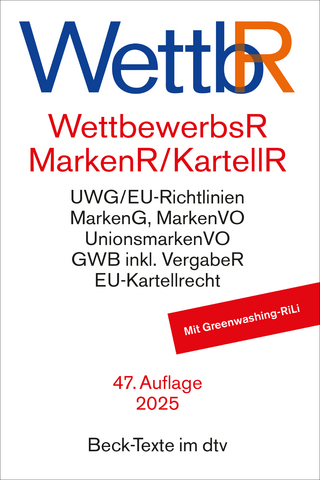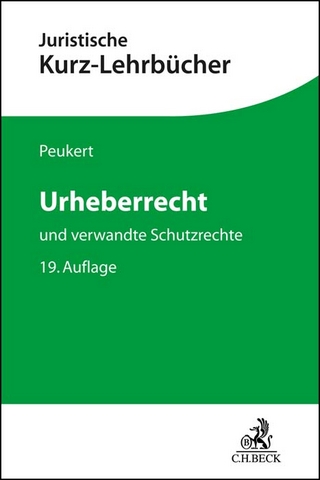
Intellectual Property, Antitrust and Cumulative Innovation in the EU and the US
Hart Publishing (Verlag)
978-1-84946-306-5 (ISBN)
For decades, the debate about the tension between IP and antitrust law has revolved around the question to what extent antitrust should accept that IP laws may bar competition in order to stimulate innovation. The rise of IP rights in recent years has highlighted the problem that IP may also impede innovation, if research for new technologies or the marketing of new products requires access to protected prior innovation. How this 'cumulative innovation' is actually accounted for under IP and antitrust laws in the EU and the US, and how it could alternatively be dealt with, are the central questions addressed in this unique study by lawyer and economist Thorsten Käseberg.
Taking an integrated view of both IP and antitrust rules – in particular on refusals to deal based on IP – the book assesses policy levers under European and US patent, copyright and trade secrecy laws, such as the bar for and scope of protection as well as research exemptions, compulsory licensing regimes and misuse doctrines. It analyses what the allocation of tasks is and should be between these IP levers and antitrust rules, in particular the law on abuse of dominance (Article 102 TFEU) and monopolisation (Section 2 Sherman Act), while particular attention is paid to the essential facilities doctrine, including pricing methodologies for access to IP.
Many recent decisions and judgments are put into a coherent analytical framework, such as IMS Health, AstraZeneca, GlaxoSmithKline (in the EU), Apple (France), Orange Book Standard (Germany), Trinko, Rambus, NYMEX, eBay (US), Microsoft and IBM/T3 (both EU and US). Further topics covered include: IP protection for software, interoperability information and databases; industry-specific tailoring of IP; antitrust innovation market analysis; and the WTO law on the IP/antitrust interface.
Dr Thorsten Käseberg, a lawyer and economist, was a case-handler at the European Commission's Directorate-General for Competition between 2009 and 2011. He is currently working in the competition policy unit of the German Economics Ministry and was previously a lecturer in the Faculty of Law and Faculty of Economics at the Humboldt University Berlin, and a research assistant at the law firm Cleary Gottlieb Steen & Hamilton in Brussels.
1. Introduction
1.1. The Previous Focus On Initial Innovation
1.2. The Need to Account for Follow-On Innovation
1.3. The Regulatory Problem and the Policy Levers
1.4. Methodology and Structure
2. The Relationship between IP and Antitrust Laws
2.1. A First Look: Two Types of IP
2.2. A Closer Look: The Anti-Competitive Potential of IP Rights
2.3. Approaches to the Relationship between IP and Antitrust
2.4. A Positive Economic Analysis of the IP/Antitrust Interface
2.5. IP or Antitrust? Some Meta Rules
2.6. Which Antitrust Rules? Some Principles
2.7. Conclusion
3. The Concepts of Monopolisation and Abuse: What is the Correct Test?
3.1. The Tests Used under § 2 Sherman Act and Article 102 TFEU
3.2. Obstacles to Cross-Fertilisation?
3.3. Analysis of Potential Standards
3.4. Conclusion
4. Refusals to Deal which May Impede Follow-On Innovation
4.1. The Traditional Typology of Refusals to Deal
4.2. Cumulative Innovation and Bargaining Rules
4.3. A Typology of Refusals to Deal involving IP
4.4. Scenario 1: Impeding Research into Follow-On Innovation
4.5. Scenario 2: Impeding the Marketing of Follow-On Innovation
4.6. Scenario 3: Refusal to Give Interoperability Information
4.7. Scenario 4: Refusal to License IP which Protects a Standard
4.8. Scenario 5: Refusal to Supply Products on the Basis of IP
4.9. Conclusion
5. The Licensing Fee: Determining Liability and the Remedy
5.1. The Royalty
5.2. The Relationship between Liability and the Remedy Price
5.3. Non-Discriminatory Pricing?
5.4. The Procedure: Bargaining, Determining the Price, Monitoring, and Enforcement
5.5. Conclusion
6. An Essential Facilities Test
6.1. Condition 1: Harm to Competition
6.2. Condition 2: No Ex Ante Investment Defence
6.3. Condition 3: No Ex Post Efficiency Defence
6.4. Conclusion
7. Cumulative Innovation under US IP and Antitrust Laws
7.1. The Initial Innovator's and the Improver's Positions under US IP Laws
7.2. The General 'No Duty to Deal' Rule under US Antitrust Law
7.3. Potential Exceptions to the No Duty to Deal Rule
7.4. The Remedy
7.5. Future Tendencies
7.6. Conclusion
8. Cumulative Innovation under European IP Laws and EU Competition Law
8.1. The Original Innovator's and the Improver's Positions under National IP Laws in the EU
8.2. Limits to Refusals to Supply Based on IP under Article 102 TFEU
8.3. The Remedy
8.4. Future Tendencies and Conclusion
9. Comparison and International Dimension
9.1. Differences between the US and EU Approaches
9.2. Potential Explanations for the Differences
9.3. The International Antitrust Law of IP
10. Summary
10.1. IP and Antitrust as the Framework for Cumulative Innovation
10.2. The Relationship between IP and Antitrust Laws
10.3. Monopolisation and Abuse: What is the Correct Test?
10.4. Refusals to Deal which May Impede Follow-On Innovation
10.5. The Licensing Fee: Determining Liability and the Remedy
10.6. An Essential Facilities Test
10.7. Cumulative Innovation under US IP and Antitrust Laws
10.8. Cumulative Innovation under European IP Laws and EU Competition Law
10.9. Comparison and International Dimension
| Erscheint lt. Verlag | 8.6.2012 |
|---|---|
| Reihe/Serie | Hart Studies in Competition Law |
| Verlagsort | Oxford |
| Sprache | englisch |
| Maße | 171 x 244 mm |
| Gewicht | 767 g |
| Themenwelt | Recht / Steuern ► EU / Internationales Recht |
| Recht / Steuern ► Wirtschaftsrecht ► Urheberrecht | |
| Recht / Steuern ► Wirtschaftsrecht ► Wettbewerbsrecht | |
| ISBN-10 | 1-84946-306-9 / 1849463069 |
| ISBN-13 | 978-1-84946-306-5 / 9781849463065 |
| Zustand | Neuware |
| Haben Sie eine Frage zum Produkt? |
aus dem Bereich


